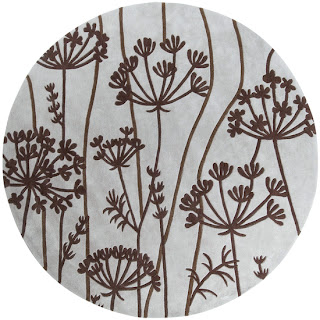This week's blog is all about what's under your feet, specifically Area Rugs, that is! Rugs come is an astounding array of sizes, colors, textures, and styles. So we've decided to help outline some information about rugs to help you make an informed and design savvy decision when choosing how to add style to those floors. Don't forget to have you room dimensions handy as that's the first step. Once you know your dimensions you can determine the material, shape/layout, color and style you would like.
Material
For starters there are some main materials used in area rugs. Cotton, Polyester, Sea Grass, Sisal, Jute, Polypropylene, Silk and Wool.Cotton is a natural fiber which is ideal for high-traffic areas and is durable, soft, and in a wide spectrum of colors.
Polyester is a synthetic materials which retains color clarity, is easily cleaned, has a soft plush feel, and is deal for living areas.
Sea Grass is a natural material which is strong, has a coarse natural texture and is ideal for high-traffic areas.
Jute is another great natural material which is easily identifiable with its natural coloring and soft feel. It should not be placed under furniture and it best in low-traffic areas.
Polypropylene is a synthetic fiber which is resistant to moisture, mildew, and mold, is easy to clean, colorfast, and best for low-traffic areas. Good for indoor or outdoor use.
Silk is a natural material which has a beautiful high luster sheen and is used to provide highlights and contrast in wool rug blends. It has a soft luxurious feel and is best for low-traffic areas.
Lastly Wool, another natural material which is soft, thick, strong, and resilient and static-resistant. It works great in high-traffic areas and may shed somewhat when new.
Construction
Along with all the materials area rugs come in there are a variety of techniques for their construction. Hand-knotted, Hand-tufted, Flat Weave, Machine-made and Hand-woven are a few of the most common techniques. Check out this link for more info about these methods and more.
http://rug-carpet-guide.com/carpet_construction2.htm
Shape/Layouts
Knowing what size of area rug and layout to choose can also be confusing. Here are some helpful hints for living, dining room, and bedroom layouts with diagrams!
Before buying a rug, it is crucial that you have the room's dimensions to ensure appropriate sizing is determined.
Don't forget about unusual shapes for area rugs, which also come in Square (perfect for large modern living rooms or under a square dining table), Oval (a more organic alternative to rectangular rugs) and Kidney (great for contemporary odd shaped spaces) as well as laying for a unique effect.

Also try two legs on the bed placed on a large rug but allow the floor to show all around the bed. The rug should be approximately 24" or more from the sides of the bed.
Color/Style
Have in mind what color goes with your existing (or new) decor. Area rugs come in every color imaginable along with many shapes and sizes. Know what style you are looking to convey to help your designer or yourself narrow in on what exactly you want. By knowing your style such as traditional, contemporary or transitional you can quickly eliminate rug options which don't suit you. You can then go more in depth into styles like Classic, Arts and Crafts, Modern, etc. If you're into bold graphic prints then you'll want to stick to the contemporary genre. Traditional tastes will most likely prefer more muted tones and Oriental styles. Transitional sits in between the two styles. By knowing your taste the process will go much faster. Rugs come in neutrals, pastels, black and white graphic, bright bold colors and more! The possibilities are endless and by choosing a great rug to compliment your space you're sure to create a cohesive finished room by adding softness and depth to the design!
To see a catalog of the beautiful rugs shown here, and more, stop in to PerLora and PerLora Leather.



































